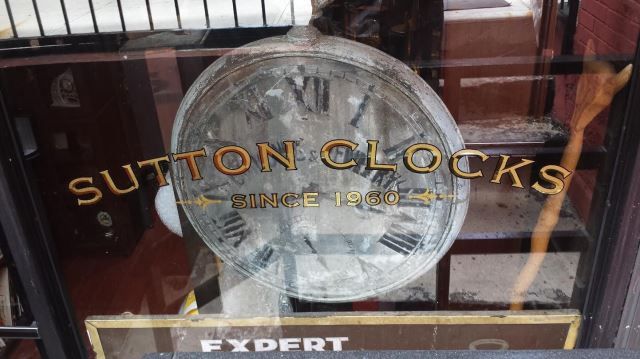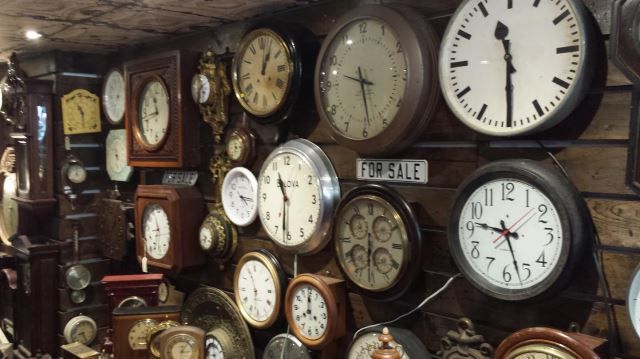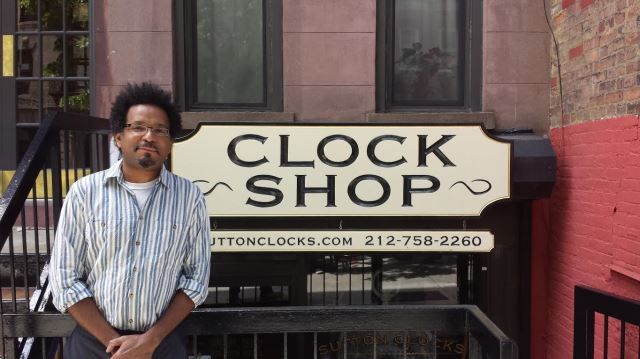How to See the Liberty Bell...in Queens
A copy of the famous American bell can be found inside a bank, which itself is modeled after Independence Hall!


Sutton Clocks: Photo Credit: Jordan Simon for Untapped Cities
Stepping across the threshold into Sutton Clocks is akin to walking into a clock maker’s private oasis. Customers who find its small enclosure off-putting will find solace in the array of clocks, both old and new, that line its walls. They’ll probably find Sebastian Laws, the shop’s owner, sitting behind a counter, repairing a vintage clock to its original luster. It’s a testament to his talents as a horologist, a trait he most likely inherited from his father, Knud Christiansen, a Danish immigrant who founded Sutton Clocks as a small pawn shop in the late 1940s.
Prior to his arrival to New York City, Christiansen was a world class athlete, competing in the 1936 Olympics as a member of the Danish rowing team. However, in a little known tale of heroism that bears similarities to Oskar Schindler and Nicholas Winton, he also spearheaded the rescue of more than 7,000 Danish Jews from the Nazis on Rosh Hashanah in 1943.
As a member of the Danish Rowing Team during the 1936 Berlin Olympics, Knud had a front row seat to the Nazi-led horrors described by his first wife, Karen Rasmussen, a few years prior. The daughter of a chief naval physician, Karen was knee deep into her studies at a prestigious cooking school when she started writing letters that documented the rise of Adolf Hitler and the brutalization of innocent Jews in Berlin. Both Knud and Karen eventually left Berlin and got married in their home country of Denmark in 1938. However, life in marital bliss became short lived in April 1940, when the Germans occupied Denmark. The advent of the German occupation of Denmark coincided with the couple’s inclusion into the Danish Resistance.
By 1943, Knud and Karen had three children and led some semblance of a normal family life. The family lived in a large apartment on the Havnegade, a waterfront promenade overlooking the canal. Knud would often spy on high ranking Nazi officers who used the promenade’s prime real estate as their headquarters. His mother owned a chocolate shop, where members of the resistance would leave messages and weapons for safekeeping.
While helping his mother around the shop, Knud would often signal to members of the Danish resistance by simply adjusting a soda bottle perched in the storefront window. To make ends meet, he worked as a manufacturer for ski poles and leather goods, an industry predominantly led by Jews. Meanwhile, his wife Karen wrote an underground newspaper entitled, “Die Warhiet” (The Truth), that translated BBC broadcasts from Dutch to German to inform Jewish citizens of the atrocities committed by Nazi Germany.
As a key member of the Danish resistance, Knud gained information about the Nazis plan to arrest all of Denmark’s Jews on Rosh Hashanah on October 1, 1943. He also learned of a burglary at a synagogue in which the only items stolen were a list of Jewish names and addresses. A few nights later on September 21, Knud spotted from his apartment window two German steamers sailing into the harbor. Noticing that both of the ships were empty, Knud believed that Jews were going to be arrested.
In an interview for the Jewish Post, Knud recalled “I called my colleagues in the resistance and told them that I feared the Jews were going to be picked up.” His wife, Karen immediately took action by distributing pamphlets that warned the Jewish citizens of Denmark to seek refuge away from their houses. At his weekly bridge game, Knud advised the Phillipsons, a band of Jewish brothers who worked as blacksmiths, to seek refuge in his apartment for safekeeping. The brothers, however, refused to heed his warning and returned home, where they were met by Nazi officers who arrested them and took them to the Horserod concentration camp.
When Knud learned of the brothers’ arrest, he drove to the Horserod concentration camp in order to orchestrate their release. Once there, Knud told the camp commander that the brothers were partly Jewish in the hopes that it would guarantee their release. According to an article from the Jewish Foundation for the Righteous, Knud even went as far as offering the camp commander a tub of butter as a bribe. Despite his best efforts, the camp commandant threatened to hang Knud if he returned.
Running out of options, Knud risked his own life by seeking help from Dr. Werner Best, the highest ranking Nazi in Denmark who earned the nickname “the Bloodhound of Paris,”for his notorious deportation of French Jews to the Nazi death camps. Knud bribed Dr. Best by promising to produce a Nazi propaganda film in which Germany would be positively portrayed as friends of Denmark. The Phillipson brothers were released a couple of days later. According to The Jewish Post, Knud’s Aryan appearance, prior success as an Olympian athlete and personal connections to the King of Denmark may have aided in Dr. Best’s decision to release the Phillipson brothers.
With Rosh Hashanah a few days away, Knud and Karen increased their rescue efforts by hiding large groups of Jewish citizens in various locations such as churches, farmhouses and even their own house. According to the Jewish Post, universities across the country closed, enabling their young students to seek refuge and aid in the rescue effort, ministers asked congregants to aid their Jewish neighbors, and Danish diplomats consulted with their Swedish counterparts to ensure a safe passage for fearful refugees. On Oct. 2nd, Sweden agreed to grant asylum to Denmark’s Jewish population. Karen’s father, Dr Holger Rasmussen, used his villa in Espergaerde, a coastal village north of Copenhagen, as a drop off point for Jewish citizens escaping from Denmark’s capital city.
With everything set in motion, Knud used his Olympic rowing skills to ferry Jewish refugees across the Oresund, a large body of water dividing Denmark and Sweden, where they were eventually taken to safety. Using his Olympic racing boat, Knud made midnight trips back and forth before he enlisted the help of larger boats to carry a larger amount of Danish Jews to Sweden. According to Yad Vashem, approximately 7,200 Jews and 700 of their relatives were safely transported to Sweden within the course of three weeks in October of 1943. In 2005, both Knud and Karen Christiansen were recognized by Yad Vashem as one of the Righteous Among the Nations for their bravery and courage. A year later, Knud Christiansen was immortalized in a 2006 painting by artist Max Ferguson entitled, “Time”.

At Sutton Clocks, customers will find an array of clocks and barometers, both vintage and new, lining its walls. Photo Credit: Jordan Simon for Untapped Cities
Karen died in 1992 and Knud eventually moved to New York City, where he spent his final years repairing clocks and barometers in a tiny loft on 61st Street until his death on February 2, 2012 at the age of 97.

Sebastian Laws, the son of Knud Christiansen, currently owns Sutton Clocks. Photo Credit: Jordan Simon for Untapped Cities
Because he spent his final years in anonymity, passerby and customers of Sutton Clocks would have never guessed that portions of Knud Christiansen’s life were similar to Schindler’s List. As one of the last tangible remnants of Christiansen’s legacy, Sutton Clocks is currently owned and managed by his son, Sebastian Laws.
Read on for our article on Economy Candy, the oldest candy store in NYC. Get in touch with the author at @jordansimon78.
Subscribe to our newsletter